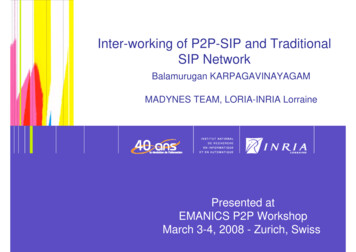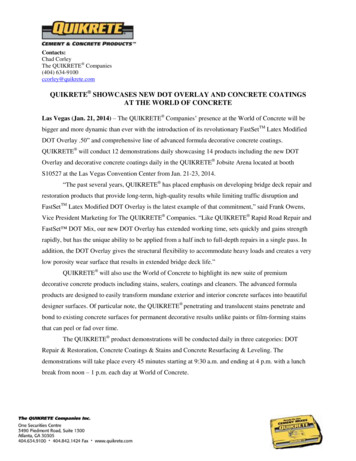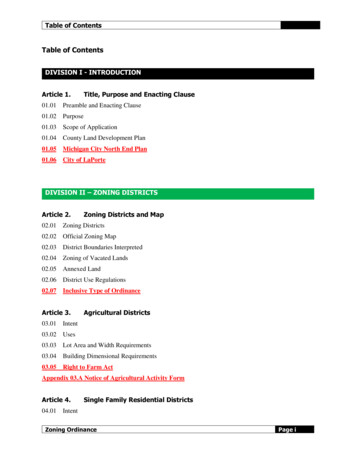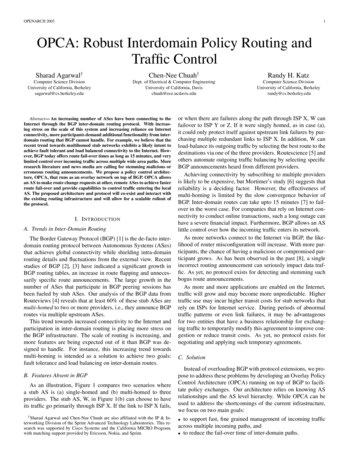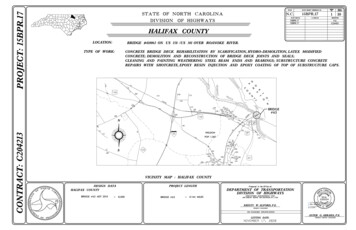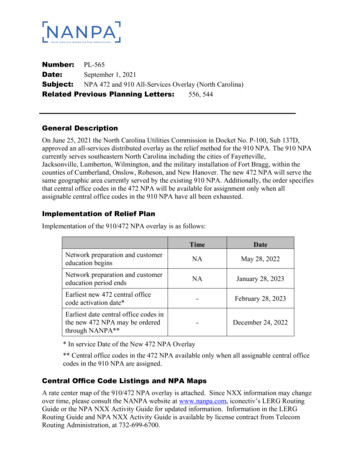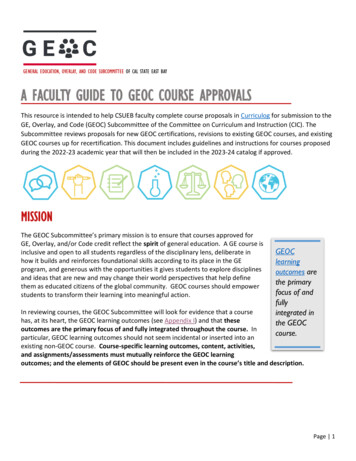
Transcription
GENERAL EDUCATION, OVERLAY, AND CODE SUBCOMMITTEE OF CAL STATE EAST BAYA FACULTY GUIDE TO GEOC COURSE APPROVALSThis resource is intended to help CSUEB faculty complete course proposals in Curriculog for submission to theGE, Overlay, and Code (GEOC) Subcommittee of the Committee on Curriculum and Instruction (CIC). TheSubcommittee reviews proposals for new GEOC certifications, revisions to existing GEOC courses, and existingGEOC courses up for recertification. This document includes guidelines and instructions for courses proposedduring the 2022-23 academic year that will then be included in the 2023-24 catalog if approved.MISSIONThe GEOC Subcommittee’s primary mission is to ensure that courses approved forGE, Overlay, and/or Code credit reflect the spirit of general education. A GE course isinclusive and open to all students regardless of the disciplinary lens, deliberate inhow it builds and reinforces foundational skills according to its place in the GEprogram, and generous with the opportunities it gives students to explore disciplinesand ideas that are new and may change their world perspectives that help definethem as educated citizens of the global community. GEOC courses should empowerstudents to transform their learning into meaningful action.GEOClearningoutcomes arethe primaryfocus of andfullyintegrated inthe GEOCcourse.In reviewing courses, the GEOC Subcommittee will look for evidence that a coursehas, at its heart, the GEOC learning outcomes (see Appendix I) and that theseoutcomes are the primary focus of and fully integrated throughout the course. Inparticular, GEOC learning outcomes should not seem incidental or inserted into anexisting non-GEOC course. Course-specific learning outcomes, content, activities,and assignments/assessments must mutually reinforce the GEOC learningoutcomes; and the elements of GEOC should be present even in the course’s title and description.Page 1
APPROVAL STEPS AND TIMELINESenate policy establishes a Timeline for Curricular Changes (17-18 CIC 35), and the Curricular ProceduresManual describes the approval process for new course, revision, and recertification requests. Morespecifically, GEOC course review policies are also described in the GEOC Framework document (21-22 CIC 55).The approval timeline for GEOC courses is highlighted below. All processes are routed and tracked throughCurriculog, CSUEB’s online course management platform.MARCHOCTOBER15DEPARTMENTCOLLEGEOnce course requestsare approved by theDepartment CurriculumCommittee/DepartmentChair and the CollegeCurriculum Committee/Associate Dean, theyare routed to AcademicPrograms and Services(APS) for review.APSCourserequestsmust reachAPS byOctober 15thof the yearprior to theeffectivecatalog year.1GEDIRECTORGEOCOnce APS approves the courserequests, they move forward tothe Director of GE and to theGEOC Subcommittee. Courserequests must be approved bythe GEOC Subcommittee andthe Committee on Instructionand Curriculum (CIC) to bemoved forward to the ExecutiveCommittee, who sets Senate’sagenda.CICSENATECourse requestsmust reach Senateby March 1st. WithSenate approval, thecourse will beincluded in thefollowing year’scatalog and offeredin fall/spring of thatcatalog year as acertified GEOCcourse.Course proposals/revision/recertification requests that do not reach APS by October 15th must be resubmitted using the appropriate Curriculog form for the next catalog year.RECERTIFICATION OF GEOC COURSESAs stated in the GEOC Framework Policy (21-22 CIC 55), existing GEOC courses will be reviewed by the GEOCSubcommittee on 5-year intervals (see figure on next page). During the 2022-23 academic year, all Upperdivision Arts and Humanities (UD-C) courses will be reviewed for recertification regardless of when they werefirst certified.Any existing GEOC course that is not approved for recertification will lose its GEOC certification beginning withthe next catalog year.Page 2
KEY POLICIES GEOC recertification reviews will occur according to the schedule regardless of when thecourse was originally certified.A GEOC course that has been banked will lose its GEOC certification(s).A GEOC recertification proposal can only be submitted for an existing GEOC course. Arevision proposal to add GEOC certification(s) must be submitted for courses that havepreviously lost their certification(s).Courses that carry a GE along with an Overlay and/or Code certifications will be reviewedfor all certifications according to the GE designation. Non-GE courses that carry both U.S.Code and Overlay certifications will be reviewed according to the Code designation.Course recertification requests must reach the APS step in Curriculog by October 15th.Page 3
MAKING A GEOC COURSE APPROVAL REQUESTThe Curricular Procedures Manual provides step-by-step instructions, timelines, and other necessaryinformation needed for proposing new courses, course revisions, or other curricular changes to academicprograms at Cal State East Bay. These procedures are incompliance with local CSUEB policy, CSU Chancellor’sOffice guidelines, and WASC accreditation standards.Contact Rick Rader, Lead CurriculumThe details most germane to GEOC course requests areServices Analyst/University Curriculumemphasized in this section.Coordinator, at rick.rader@csueastbay.eduAll GEOC course proposals are digitally completed,launched, and tracked through Curriculog. Courseproposals created in a separate Word or PDF documentwill not be accepted.for Curriculog questions, issues, and/ortraining requests.SELECTING THE CORRECT GEOC COURSE PROPOSAL FORMCurriculog forms for GE, Overlay, Code, and Second Composition courses, collectively termed Breadth courses,are now distinguished by the action being requested. All Breadth categories are all included on each form,eliminating the need to submit separate proposals for a course that has more than one Breadth certification.The GEOC-related Curriculog forms are:Use this form if you want to Course - Breadth (GEOC) - Recertification ONLY(2022-23 AY) Recertify an existing UD-C course (and any associatedOverlay) with no revisions.*Course – Breadth (GEOC) –Revision/Recertification (2022-23 AY) Both revise and recertify an existing UD-C course (and anyassociated overlay); or Revise an existing GEOC course, including the request to adda new GEOC certification.Course – Breadth (GEOC) – NEW (2022-23 AY) Certify a new course that has never been in the catalog.* Any course revisions made to the Recertification Only course proposal once it has been launched may require theproposal to be redone on the Revision/Recertification form.COMPLETING THE GEOC COURSE PROPOSALInstructions and requirements for completing the GEOC course proposal form are clearly explained within theCurriculog form. Links to helpful resources for developing/refining courses and completing the proposal areprovided in the form.Page 4
GEOC COURSE REVISION TYPESSection 4A of Revision/Recertification and Revision Only FormsGEOC course revisions that are carefully reviewed by the GE Director and the GEOC Subcommittee include(but are not limited to): Adding GE, Overlay, or Code credit to an existing course;Adding or changing the course delivery format (e.g., moving from on-ground to online);Changing the course description and/or course learning outcomes;Adding or removing a pre-requisite or co-requisite.Although all GEOC revision requests will be reviewed by the GE Director, some changes to an existing GEOCcourse may not be reviewed by the GEOC Subcommittee, including changes to course type, course number,course prefix, course units, grading pattern, and repeatability. Distinctions are made between revisions thatare actionable by CIC/Senate or presented to CIC/Senate by the GEOC Subcommittee as information itemsonly (see Appendix II).MONITORING YOUR CURRICULOG COURSE PROPOSALKeep track of all comments and decisions posted to your Curriculog proposal once it leaves your step. ACurriculog Activity Digest will be emailed to you whenever proposals in which you are involved have beenacted on (e.g., comments added, moved to the next step, re-routed). The proposal may be rejected ordelayed due to incorrect or missing information. Prompt response to any proposal delay will ensure theproposal moves through the approval steps as expeditiously as possible and increases the chances of GEOCapproval.The most common problems that delay course proposals at the APS/GE Director’s steps (prior to reaching theGEOC Subcommittee) are:1234Course syllabi lack the relevant GE/Breadth learning outcomes.A representative syllabus for each instructional format is not provided.Course-specific learning outcomes listed in the proposal form and catalog differ from those listed in thecourse syllabi provided.Information provided in the form and/or syllabus is too vague orinsufficient to ascertain how the course addresses the GEOClearning outcomes and/or course criteria.In addition, keep track of when your course will be on the GEOCSubcommittee meeting agenda and up for discussion/review. GEOCmeetings are open to all faculty guests. Consult with your college’s GEOCSubcommittee or CIC representative. You may request a time certainfrom the GEOC Subcommittee Chair.GEOC Subcommitteemeets on the 2nd & 4thWednesdays of eachmonth from 2 – 4 PM inSF 328 or by Zoom.Page 5
GEOC REVIEW CRITERIA AND GUIDELINESThe Director of GE and the GEOC Subcommittee base their evaluationsand decisions on the information you provide in the proposal form andin the representative course syllabi. These are the pieces of evidenceused to determine whether the course clearly meets all the stated GEOClearning outcomes and course characteristics (if applicable) in eachinstructional format proposed.Check the GEOCfor Faculty page forexemplary GEOCcourse proposals.Highlighted in the table below are the important criteria and guidelines to keep in mind when applying for anew GEOC-certification, recertification, and/or revision request.COURSE INFORMATION [Section 4B Course Catalog Data]Course/Catalog DescriptionCourse emphasis is consistent with GEOC learning outcomes. For revision/recertification or revision onlyrequests, check that the course description is consistent with what is stated in the course syllabi.Course OutcomesCourse-specific student learning outcomes are congruent with GEOC learning outcomes. Forrevision/recertification or revision only requests, check that the course outcomes are consistent withthose stated in the course syllabi.Course CapEnrollment capacity is in compliance with course category. UD-C and UD-D courses have a course cap of30 students.Course Pre/Co-RequisitesGE courses are not major-level courses with several major-level prerequisites. All upper-division GE (UD-B,UD-C, and UD-D) courses have the prerequisite of completion of A1, A2, A3, and B4 with grades of C- (CR)or better. B4 courses must have a co-requisite support class for students classified as needing support.Although GE courses may have upper-division and/or major level prerequisites, such a course may becontrary to the purpose and spirit of General Education.EVIDENCE OF COURSE ALIGNMENT TO GEOC LEARNING OUTCOMES [Section 6]Learning Experiences/Activities in Support of Student LearningFor each GEOC learning outcome, representative examples of learning experiences/activities that movestudents toward achievement of the learning outcome are clearly explained. These experiences mayinclude strategies/activities used as formative assessment of the relevant concept. Provide someexamples of specific concepts/ideas that will be supported by the activity. Keep in mind that theexperience/activity listed should align to the instructional mode (i.e., on-ground, hybrid, and/or online).Here are some examples: Students will engage in storyboarding and concept mapping activities, which are effective inhelping students visualize and make sense of complex biological phenomena, particularly thoseinvolving cause-effect mechanisms (e.g., biogeographical phenomena), sequences of events (e.g.,gene expression), and patterns amongst an array of inter-related factors involved in a regulatorymechanism (e.g., many physiological mechanisms). These activities will be done in small groupsfor on-ground/hybrid course delivery and individually with peer feedback when the course istaught online.Page 6
Students will respond to short writing prompts, in order to facilitate the application ofappropriate terminology and concepts learned in class (provide example) and check forunderstanding or misconceptions (provide example). These prompts will be turned in at the endof class as “exit tickets” for on-ground/hybrid course delivery or as an online assignment whenthe course is taught online. As a capstone activity done at the end of the term, students will participate in a structured debateon in order to reinforce the concept that (for exclusively on-ground course delivery). Students will write an argumentative essay on the ., which will be scaffolded with shorter writingassignments throughout the term. Students will watch videos in class/online on and participate in in-class/online (via Bb DiscussionBoard) group discussion in response to a specific question addressing Demonstration of Learning/Evaluation of Student WorkFor each GEOC learning outcome, representative examples of how students will be expected todemonstrate achievement of the learning outcome are clearly explained. These examples may includesummative assessments, e.g., graded performances on exams, quizzes, final projects. The assessmentsshould match the instructional mode. Here are some examples: Students will create a concept map showing the interactions between an array of factors involvedin the regulation of blood pressure. Student performance on periodic exams and quizzes will be assessed using established answerkeys, in order to determine mastery of the given concept. Student writing will be evaluated using an established rubric COURSE CHARACTERISTICS [Section 7]GEOC Course Characteristics MetThe GEOC Subcommittee will review the information provided in the proposal form as well as therepresentative course syllabi to determine whether all specified course characteristics are met in allinstructional formats (on-ground, online, and/or hybrid).For example, consider a UD-C or UD-D course delivered under multiple formats—how will the oral/manualcommunication and the peer collaboration requirements be fulfilled on-ground vs. online; how will theadvanced writing requirement be met (which assignments will add up to the 4,000 word min.requirement) and will students receive timely critical feedback on their writing from the instructor?Consider a UD-B course delivered under any format—does the syllabus list topics/activities that clearlydemonstrate a primary focus on mathematics/quantitative concepts and skills?COURSE SYLLABUSSyllabus for Each Instructional ModeRepresentative course syllabus(i) for each instructional mode (on-ground, and/or online) mustbe uploaded which clearly distinguishes online from in-person aspects of the course (if multipleformats are proposed).Statement of GEOC Learning OutcomesAll course syllabi for any GEOC-certified course must explicitly state the relevant GE/Breadth area learningoutcomes (as published in the University Catalog) in addition to the course-specific learning outcomeswhenever the course is taught (see new CIC syllabus policy).Course Topics/Activities in Support of GEOC Learning OutcomesPage 7
The topics and activities listed in representative course syllabus(i) are congruent with and support thestated GEOC learning outcomes.GEOC SUBCOMMITTEE DECISIONSUpon first review of the course, the Director of GE and/or GEOC Subcommittee will approve the course forGEOC re/certification, table their decision for consultation and possible revision, or reject the course forGEOC re/certification. When the GEOC Subcommittee decides to place a proposal on hold (“table” theirdecision) for additional information, clarification, corrections, and/or revisions, two actions are prompted:1. An email notification is sent from the GEOC chair and/or college liaison to the department chair/originator of the proposal with detailed comments from the GEOC Subcommittee and what isrequested in order for a secondary GEOC Subcommittee review. The chair/liaison can address anyquestions or concerns. The department is invited to attend an upcoming GEOC meeting.2. The GEOC Subcommittee will review the updates and/or additional information provided by thedepartment and will then render their final decision to approve or reject the proposal.The diagram below summarizes what happens to a course proposal once the Subcommittee renders adecision to approve, table, or reject.APPROVETABLEREJECTCICEmail notification tochair/originator fromGEOC liaison orGEOC chairSenateUpdates/additional inforeviewed by GEOCGEOCapproves orrejectsOption to revise and reapply for next catalog year. A new Curriculogform must be completed and submitted by the Oct. 15th deadline.Page 8
APPENDIX 1. GE/BREADTH LEARNING OUTCOMESGE/BREADTHAREALEARNING OUTCOMESCOURSE CHARACTERISTICS (CRITERIA), ifapplicableUpon completion of the requirement,students will be able to A1 OralCommunication1. speak effectively when making oralpresentations in English;2. explain the principles of effective oralcommunication, including form, content,context, and style;3. advocate for a cause or idea, presentingfacts and arguments in an organized andaccurate manner; and4. critically evaluate oral presentations.The A1 course is primarily based uponcommunication theory presented throughlecture, discussion, and reading. It mustprovide several face-to-face opportunities for aplanned sequence of speaking and listeningexperiences in two or more of the followingmodes:a) small-group (problem-solving) discussion,b) interpersonal communication,c) expository discourse presentedextemporaneously,d) argumentative and persuasive discoursepresented extemporaneously.Students must complete three or moreassignments to demonstrate increasing skill inoral communication. Instructors must providestudents with frequent feedback andconstructive criticism on students’ oralpresentations. For online or hybrid classes, aminimum of 50% of the speaking and listeningactivities must be synchronous, interactiveexperiences. Recorded formats are allowed toaccommodate the online environment.A2 WrittenCommunicationA3 CriticalThinking1. write effectively in English;2. explain the principles and rhetorical perspectives of effective writing, including its form,content, context, and style;3. advocate for a cause or idea, presenting facts and arguments in an organized and accuratemanner; and4. practice the discovery, critical evaluation, and reporting of information.A3 courses include evidence that the course1. understand logic and its relation tocontent encompasses:language, elementary inductive anda) Logic: the structure and purpose of andeductive reasoning, and formal andargument, the logical relationships betweeninformal fallacies;the parts (explicit and implicit) and evaluation2. demonstrate the ability to distinguishof the argument.among different sorts of claims, such asb) Deductive Reasoning: arguments intendedstatements of opinion, reasonedto reason with certainty or necessity and thejudgments, proofs, and articles of faith;evaluation of them in terms of validity and3. develop the ability to identify, analyze,soundness. This includes the use of formalevaluate, and present arguments, andsystems (e.g., propositional logic, predicatePage 9
construct arguments both to support andrefute claims; and4. develop the ability to reason inductivelyand deductively.B4 Math/QuantitativeReasoningB1 PhysicalScienceB2 Life ScienceB3 LaboratoryActivitylogic, syllogistic logic) and/or informal systems(e.g., mathematical reasoning, argument bydefinition).c) Inductive Reasoning: arguments intended toreason without necessity or certainty and theevaluation of them in terms of strength andcogency. This includes reasoning such as causalanalyses, arguments from analogy,generalizations, appeals to authority,predictions, and/or abductive reasoning.d) Language: the role of language inargumentation (e.g., factual and value claims,vagueness and ambiguity; cognitive andemotive meaning; definitions; implicit andexplicit communication).e) Fallacies: common errors in reasoning bothinformal (e.g., ad hominem, slippery slope,bias, strawman, equivocation, no trueScotsman, false cause) and formal (e.g.,affirming a disjunction, denying theantecedent).In B4 courses, students will not just practicecomputational skills, but will engage in morecomplex mathematical work, in accordance withthe CSU GE B4 Guidelines and Principles. B4courses will have a corresponding support classfor students classified as needing support.Exceptions may be made for B4 courses thathave another B4 as a prerequisite, such asCalculus.1. demonstrate a proficient and fluent abilityto reason quantitatively;2. demonstrate a general understanding ofhow practitioners and scholars collect andanalyze data, build mathematical models,and/or solve quantitative problems; and3. apply quantitative reasoning skills in avariety of real-world contexts, defined bypersonal, civic, and/or professionalresponsibilities.1. demonstrate knowledge of scientific theories, concepts, and data about the physicalsciences;2. demonstrate an understanding of scientific practices, including the scientific method; and3. describe the potential limits of scientific endeavors, including the accepted standards andethics associated with scientific inquiry.1. demonstrate knowledge of scientific theories, concepts, and data about the life sciences;2. demonstrate an understanding of scientific practices, including the scientific method; and3. describe the potential limits of scientific endeavors, including the accepted standards andethics associated with scientific inquiry.B3 courses will emphasize safety and1. apply their knowledge of scientificcollaboration in a laboratory setting, especiallytheories, concepts, and data about thefocusing on data collection, analysis, andphysical and sciences through laboratorypresentation.activities;2. apply their understanding of scientificpractices, including the scientific methodin a laboratory setting; andPage 10
C1 ArtsC2 HumanitiesD1-2 SocialSciencesE LifelongLearning andSelfDevelopmentF Ethnic Studies3. apply accepted standards related to safetyand ethics associated with conducting andcommunicating scientific inquiry, whilecompleting laboratory activities.1. demonstrate an appreciation of the arts using their intellect, imagination, sensibility, andsensitivity;2. respond to aesthetic experiences in the arts and develop an understanding of the integrityof both emotional and intellectual responses; and3. in their intellectual and subjective considerations, demonstrate an understanding of therelationship among the self, the creative arts, and culture.1. show appreciation for the humanities using their intellect, imagination, sensibility, andsensitivity;2. develop their affective and cognitive faculties through studying great works reflecting therich diversity of human imagination and/or inquiry; and3. engage in critical self-reflection relating themes in the humanities to the students’ ownlives.1. specify how social, political, economic, and environmental systems and/or behavior areinterwoven;2. explain how humans individually and collectively relate to relevant sociocultural, political,economic, and/or environmental systems-how they produce, resist, and transform them;3. discuss and debate issues from the course’s disciplinary perspective in a variety of cultural,historical, contemporary, and/or potential future contexts; and4. explore principles, methodologies, value systems, and ethics employed in social scientificinquiry.1. develop intellectual, practical, and/or physical skills and abilities that will serve themthroughout their lives;2. apply their learning to other pursuits within and outside of the classroom; and3. demonstrate the capacity to make informed and ethical decisions.[Note: Courses must meet 3 of the following All courses approved for Area F mustdemonstrate use of Ethnic Studies pedagogies5 outcomes to be certified for Area F. The 3as evidenced byoutcomes that are met in the course will be1. centering decolonization, self-determination,published in the course syllabus.]and anti-racism as central components within1. Using a comparative or focused approach, Ethnic Studies teaching;explain and analyze core concepts such as 2. developing students’ critical consciousness(or their critical understanding of the world andracialization, racism, white supremacy,their place in it);racial capitalism, critical race theory,3. including culturally responsive approachesintersectionality, women of colorthat build upon students’ experiences andfeminisms, queer of color theory,perspectives;(counter)hegemony, eurocentrism, self4. creating caring and empathetic academicdetermination, food justice inenvironments;communities of color, environmental5. building upon students’ cultural knowledgejustice, liberation, decolonization,so that students find the agency to creategenocide, sovereignty, indigeneity,culture and communities amongst themselves;imperialism, settler colonialism,6. developing students’ agency so that they canantiBlackness, or anti-racism as analyzeduse their education to respond to the needs inin Native American/Americantheir communities beyond the classroom.Page 11
Indian/Indigenous Studies, Chicana/o/x orAll courses must include study of resistance,Latina/o/x Studies, Africansocial justice work, and agency of scendent of EnslavedAfrican Studies, Asian/PacificIslander/Middle Eastern/South Asian(APIMESA) American Studies.2. Apply theory and knowledge such asCritical Race Studies and Women of Colorfeminisms produced by AmericanIndians/Native Americans/Indigenouspeople, African Americans/Blackpeople/African diasporic/AfricanDescended/Descendant of EnslavedAfricans, Asian/Pacific Islanders/MiddleEastern/South Asian (APIMESA) Americansand/or Latinas/os/xs or Chicanos/as/xs todescribe the critical events, histories,cultures, intellectual traditions,contributions, lived experiences, andsocial struggles of those groups with aparticular emphasis on group affirmation,agency, and praxis.3. Critically analyze the Black feministconcept of intersectionality and theintersection of race, class, and gender withother axes of oppression includingsexuality, sexual violence,religion/spirituality, national origin,immigration and citizenship status, ability,Indigenous sovereignty, language, and/orage as they apply to AfricanAmerican/Black/African diasporic/AfricanDescended/Descendant of EnslavedAfrican, Chicana/o/x or Latina/o/x,Asian/Pacific Islander/MiddleEastern/South Asian (APIMESA) American,and/or Native American/AmericanIndian/Indigenous communities.4. Critically review how struggle, resistance,rematriation, social justice activism,solidarity, abolition, and liberation, asexperienced, enacted, and studied byAmerican Indians/NativeAmericans/Indigenous people, AfricanAmericans/Black people/Africandiasporic/African Descended/Descendantof Enslaved Africans, Asian/PacificPage 12
UD-B Upperdivision ScienceInquiry andQuantitativeReasoningIslanders/Middle Eastern/South Asian(APIMESA) Americans and/orLatinas/os/xs or Chicanos/as/xs arerelevant to current and structural issuessuch as communal, national, international,and transnational politics as for example,in health disparities, educationalinequities, immigration policies,reparations, settler-colonialism, languagepolicies, media depictions of ethnic/racialgroups, racial and sexual violence, prisonindustrial complex, communitydevelopment, gentrification, and/or otherethnic politics.5. Describe and actively engage withAmerican Indian/NativeAmerican/Indigenous, AfricanAmerican/Black/African diasporic/AfricanDescended/Descendant of EnslavedAfrican, Asian/Pacific Islander/MiddleEastern/South Asian (APIMESA) Americanand/or Latina/o/x or Chicano/a/xcommunities to apply anti-racist, anticolonial, humanizing, and women of colorfeminist frameworks to radically reimaginetheir communities as sites of justice andlove.1. demonstrate advanced and/or focusedscience or quantitative content knowledgein a specific scientific field, usingappropriate vocabulary and referencingappropriate concepts (such as models,uncertainties, hypotheses, theories, andtechnologies);2. apply advanced quantitative skills (such asstatistics, algebraic solutions,interpretation of graphical data) toscientific problems and evaluate scientificclaims;3. demonstrate understanding of the natureof science and scientific inquiry and theexperimental and empiricalmethodologies used in science toinvestigate a scientific question or issue;and4. apply science content knowledge tocontemporary scientific issues (e.g., globalUD-B courses should include assignments that,where possible, allow for the assessment of thefollowing:a) Information literacy. Students should be ableto describe how they determined whatinformation they needed to complete theiranalysis or research, how they evaluated thevalidity of their sources, and show properintegration/citation of their sources in theirwork, as well as apply their abilities todifferentiate between science and pseudoscience.b) Critical thinking in the context of a scientificor quantitative discipline. For example,students should be able to explain themethodologies by which conclusions arereached, and limitations of models used thatmay affect the reliability of those conclusions.Page 13
UD-C Upperdivision Arts orHumanitiesUD-D Upperdivision SocialSciencesDiversityOverlaywarming) and technologies (e.g., cloning),where appropriate.1. demonstrate an understanding of andabi
and Curriculum (CIC) to be ommittee, who sets Senate's Course requests must reach Senate by March 1st. With Senate approval, the course will be included in the following year's catalog and offered in fall/spring of that catalog year as a certified GEOC course. DEPARTMENT COLLEGE APS GE DIRECTOR GEOC CIC SENATE
